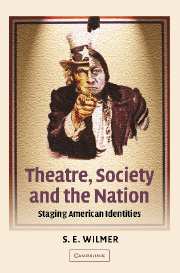Book contents
- Frontmatter
- Contents
- Acknowledgements
- Introduction
- 1 From British colony to independent nation: refashioning identity
- 2 Federalist and Democratic Republican theatre: partisan drama in nationalist trappings
- 3 Independence for whom? American Indians and the Ghost Dance
- 4 The role of workers in the nation: the Paterson Strike Pageant
- 5 Staging social rebellion in the 1960s
- 6 Reconfiguring patriarchy: suffragette and feminist plays
- 7 Imaging and deconstructing the multicultural nation in the 1990s
- Notes
- Select bibliography
- Index
3 - Independence for whom? American Indians and the Ghost Dance
Published online by Cambridge University Press: 22 September 2009
- Frontmatter
- Contents
- Acknowledgements
- Introduction
- 1 From British colony to independent nation: refashioning identity
- 2 Federalist and Democratic Republican theatre: partisan drama in nationalist trappings
- 3 Independence for whom? American Indians and the Ghost Dance
- 4 The role of workers in the nation: the Paterson Strike Pageant
- 5 Staging social rebellion in the 1960s
- 6 Reconfiguring patriarchy: suffragette and feminist plays
- 7 Imaging and deconstructing the multicultural nation in the 1990s
- Notes
- Select bibliography
- Index
Summary
For centuries, the indigenous people of North America have used their religious and performance traditions to help construct an image of themselves and their place in the world. When the advent of the white settlers began to affect their lifestyles, the American Indians devised numerous strategies to cope with their new circumstances. This chapter focuses on the Ghost Dance religion, which spread across the United States in the late nineteenth century, and examines especially the ways in which the Lakota (known also as the Sioux) practiced it.
Although the Ghost Dance was far from theatre in the conventional sense, it can be considered as manifesting similar performative features. In anthropology and in the growing area of performance studies which attracts anthropologists as well as theatre specialists, scholars have studied rituals, religious ceremonies, plays, dance, carnivals and other kinds of public events for their common elements. For example, Richard Schechner has written, “Performance is no longer easy to define or locate: the concept and structure has spread all over the place. It is ethnic and intercultural, historical and ahistorical, aesthetic and ritual, sociological and political. Performance is a mode of behavior, an approach to experience; it is play, sport, aesthetics, popular entertainments, experimental theatre, and more.”
Millennial cults like religious ceremonies and rituals have also been included in this field. The anthropologist Weston La Barre in The Ghost Dance: Origins of Religion has shown that such phenomena arise out of the community in times of crisis.
- Type
- Chapter
- Information
- Theatre, Society and the NationStaging American Identities, pp. 80 - 97Publisher: Cambridge University PressPrint publication year: 2002



